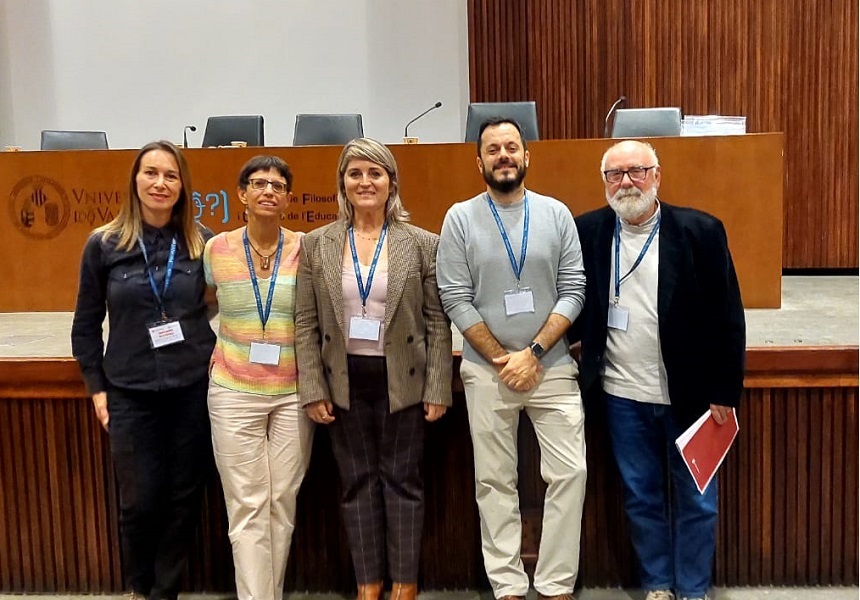Scientists uncover the hydrodynamic secret of early vertebrates
- Marketing and Communication Service
- Olga Denia Moreno
- July 10th, 2025

A research team led by the Cavanilles Institute of Biodiversity and Evolutionary Biology (ICBiBe) of the University of Valencia has revealed how certain primitive vertebrates used their skeletons to improve their stability and hydrodynamic performance. The study, published in the journal Paleobiology, has been conducted using advanced virtual palaeontology techniques and fluid dynamics simulations.
More than 400 million years ago, some vertebrates developed structures similar to those of an aeroplane in mid-flight to move more efficiently through water. These were the ostracoderms — armoured, jawless fish that inhabited the oceans during the Palaeozoic era. This has been revealed in a study led by researchers of the University of Valencia analysing how these primitive vertebrates used their skeletons to improve their stability and hydrodynamic performance.
Ostracoderms have traditionally been considered clumsy creatures, mainly due to the presence of heavy bony shells covering their heads and the absence of paired fins, equivalent to the arms and legs of later vertebrates. However, the current study published in Paleobiology challenges this view. Using advanced virtual palaeontology techniques and fluid dynamics simulations, this group of palaeontologists has discovered that these bony shields, along with certain protrusions, functioned as hydrodynamic stabilisers, allowing them to glide through water with greater control and efficiency.
A design reminiscent of aeroplanes, but in water
The results indicate that many species of ostracoderms developed lateral and dorsal extensions on their shields, which, like an aeroplane’s wings, generated lift and reduced drag. Additionally, the combination of these processes contributed to stability during turns and directional changes, analogous to the interaction between an aeroplane’s empennage and the rest of the aircraft. This reveals the direct involvement of fluid mechanics principles in the development and evolution of these animals.
“Our work demonstrates that the evolution of these primitive fish was not simply a race towards more active and faster forms, but that there was a great diversity of locomotor strategies”, explains Humberto Ferrón, researcher at the ICBiBe of the University of Valencia and co-author of the study. “Many ostracoderms probably swam efficiently in open waters, using their bony structures for stabilisation, rather than dragging themselves along the seabed as previously believed”.
Functional diversity in early vertebrates
A comparative analysis of more than 60 three-dimensional models of ostracoderms has revealed that different groups evolved similar structures independently, a phenomenon known as convergent evolution. Some species developed frontal extensions that reduced hydrodynamic resistance, while others evolved lateral expansions that increased lift and stability, favouring energy efficiency during swimming.
“When we analysed the data, we realised that the evolution of these primitive fish was much more complex than previously thought”, comments Vicente Sánchez-Sánchez, the study’s lead author. “These fish did not have simple shapes without sophisticated adaptations; in fact, their biomechanics exhibit hydrodynamic solutions that are found in many aquatic animals today”.
The simulations also indicate that ostracoderms with large dorsal and lateral extensions would have maintained greater stability in the water column, while those with more compact bodies and no additional structures would have been more manoeuvrable in coastal and shallow environments.
The article highlights that the evolution of early vertebrates did not follow a single direction but rather diversified in response to different environmental interactions. “They did not evolve solely towards faster and more active forms, but diversified in how they interacted with their surroundings. While some optimised for speed and stability in open waters, others became more agile in complex habitats”, adds Óscar Sanisidro from the University of Alcalá and co-author of the study.
This study not only reshapes current perceptions of early vertebrate evolution but also demonstrates how nature experimented with hydrodynamic principles long before humans began designing efficient structures for moving in water.
The research was conducted by the MacroFun group (Macroevolution and Functional Morphology Research Group, https://macrofun.es/), led by Humberto Ferrón at the University of Valencia. The team specialises in the analysis of major evolutionary transitions using advanced tools in biomechanics, ecology and evolution.
In addition to the UV team, researchers from the University of Alcalá and the University of Bristol (UK) also participated in the study.
Reference:
Functional aspects of the headshield processes in ostracoderms. Vicente Sánchez-Sánchez, Oscar Sanisidro, Humberto G. Ferrón. Paleobiology.
Categories: Ciencias de la Vida















